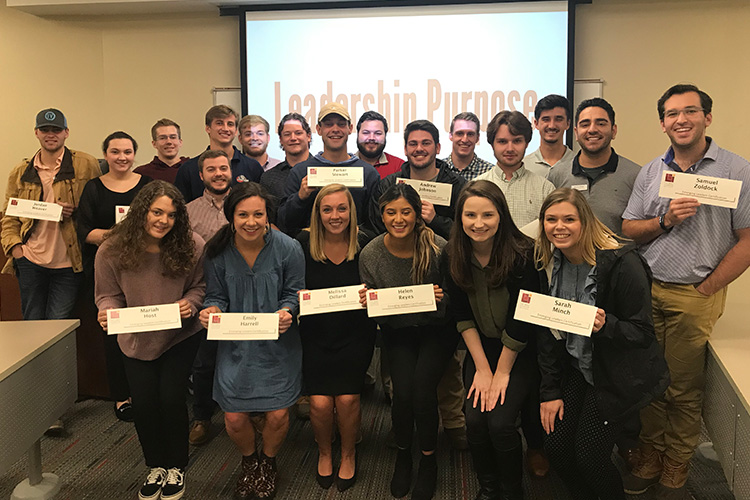
Today’s college students are our world’s next business leaders, and The BB&T Leadership Institute is making strides in helping prepare these students for leadership success after college.
On Oct. 24-25, Samford’s Brock School of Business hosted The BB&T Leadership Institute’s Emerging Leaders Certification Program, a program offered to university business schools across the country at no cost in an effort to help refine their students’ leadership skills. The certification program is based on the foundation that “beliefs drive behaviors, which produce results.” Piloted in the 2014-15 academic year, the program has already certified nearly 8,000 students across the country.
“BB&T truly believes in the power of a strong mission”, said Kevin Ortiz, a BB&T student leadership fellow and instructor of the course held at Samford. “One portion of our mission is to make the communities that we are in better and one way we do that is by creating better leaders.” He went on to add that “the quality of an organization cannot exceed the quality of its leadership”, a quote made by James Farr, Ph.D., founder of The BB&T Leadership Institute’s legacy firm, Farr Associates.
The six-hour certification program consisted of two sessions. The first titled “Leaders Aren’t Born” reflected on the idea that no one is born a perfect leader. Although some people may have natural leadership tendencies, others can improve their skills through training and development. This session allowed the student participants to identify strengths within themselves and others.
Secondly, the session titled “What’s Your Strategy?” focused on leadership behaviors by using the internally developed Leadership Preferences InventoryTM (LPI) assessment. This assessment defines the participant’s leadership preferences which is dependent on his or her definition of success. During the session, participants learned about the benefits and potential negative perceptions of their non-stress preferences as well as preferences in opposition and conflict. Finally, they learned about a new communication strategy called Active Constructive Responding that strengthens relationships.
“In the second session we spent time analyzing each of our own leadership styles, segmented as either the director, coach, problem solver, or some mix of the three,” said Dane Dunnavan, a senior majoring in finance. “Before the course we had each taken a leadership personality test, so throughout the program we were able to relate the content to our actual personalized test results.”
“Mr. Ortiz helped us understand not just our innate strengths, but more importantly the weaknesses in our unique leadership abilities that we may not have previously recognized,” Dunnavan added.
Dunnavan spoke to the open discussion the group had about how to work to overcome those weaknesses. He learned that he personally struggles to slow down long enough in his decision-making process to take into account all the facts and data, and that he tends to jump to conclusions too quickly.
“With this in mind I will focus on stepping back from situations to engage with more perspectives and understand the facts better before making a decision,” Dunnavan added.
At the end of the certification program, Samford students created their own leadership purposes. Their statements included goals for their personal leadership, action items to take toward becoming a good leader, and how they want to be perceived by others in a leadership role. They were even able to download a certificate badge to enhance their professional LinkedIn profiles.
“We are grateful for community partners like The BB&T Leadership Institute for providing resources such as the Emerging Leaders Certification program to our students,” said director of professional success Kathryn Boyd. “The program helped enhance their leadership skills through assessments and interactive exercises where they were challenged to reflect on their own leadership styles as well as other classmates.”
“At Brock School of Business, we encourage students to attend professional development workshops because we see how they help them grow into more prepared businessmen and businesswoman as they enter the workforce,” Boyd added. “Our students value professional development events and they said that this program really impacted their thoughts about leadership and what it means to truly develop leadership qualities.”
“I think the folks here at Samford are doing a fantastic job at preparing these students for business leadership,” Ortiz closed. “These young folks are incredible. Our older generations need to coach the younger generations, but we also need to listen to them and hear their ideas because this world is ever-changing and evolving. They are the next generation of leaders in the world. The better the students understand themselves and each other, the better they can lead an organization.”
About The BB&T Leadership Institute
In 1957, Dr. James Farr founded Farr Associates in a mission to apply psychological concepts to leadership development. He provided consulting services and leadership developmental workshops to companies for more than 30 years. His tenet that self-awareness is the key to compelling leadership and business success was a substantial part of BB&T‘s leadership development curriculum. In 1994, BB&T purchased Farr Associates, effectively pairing Farr’s expertise in psychology with proven BB&T leadership development programs. In 2014, Farr Associates was rebranded as The BB&T Leadership Institute. Today, The Leadership Institute unites the corporate leadership curriculum of BB&T and psychological research findings in the emerging leaders program.
The BB&T Leadership Institute’s mission includes, “Expanding the learning experiences of the next generation of leaders by creating awareness of financial literacy and leadership concepts.” The Student Leadership Programs Team works on both of these initiatives but focuses on leadership concepts at the collegiate level.

